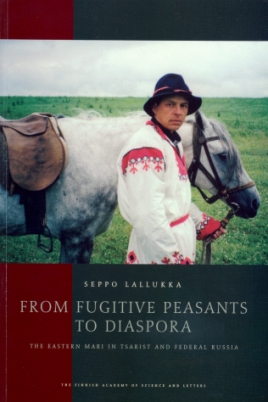

CONTENTS
ACKNOWLEDGEMENTS
A NOTE ON TRANSLITERATION AND GLOSSARY
1. INTRODUCTION
2. INTRASTATE DIASPORA AND THE ISSUE OF ETHNIC MOBILIZATION
2.1. Ethnonational Aspirations in Non-Dominant Communities
2.1.1. Identity Diffusion and the Question of Nationhood
2.1.2. Nation-Building in Eastern European Peripheral Communities
2.2.1. Sovereignization Drives and the Constellation of Interethnic Relations
2.2.4. Towards a Typologization of Mari Diaspora Communities
3. THE WAR-TORN SIXTEENTH CENTURY AND THE OUTSET OF THE EASTWARD PUSH
3.1. The Mari Homeland in the Late Middle Ages and the Early Slavic Contacts
3.2. Between the “Tatar Wolf” and the “Russian Bear”
3.3. The Cheremis Wars: Guerrilla Struggle for Independence
3.4. Russian Governance and the Early Eastward Migration Push
4. EAST OF THE VIATKA: THE RESETTLEMENT THRUST
4.1. Migration Routes and the New Environs
4.2. Causes and Consequences of the Movement in the Pre-Petrine Period
4.2.1. The Status of the Volga Peoples: General Remarks
4.2.2. Emigration Waves and Their Background
4.2.3. The Destination East
4.3. From Peter to Catherine: Consolidation of the Ethnic Enclaves
4.3.1. Governmental Policies and Spontaneous Peasant Mobility
4.3.2. The Breakthrough in the Conversion Efforts of the Middle Volga Mari
4.3.3. Government-Induced Migration
4.3.4. The Completion of the Settlement Network
4.4. Conclusion
5. THE NATIONAL MOVEMENT, TERRITORIAL SOLUTION, AND SOLIDIFICATION OF THE DIASPORA–HOMELAND RELATIONSHIP
5.1. From Protonational Consciousness towards “Imagined Community”
5.2. Seeds of Mobilization: Enlightened Minority Patriotism
5.3. The First Year of the National Movement
5.4. The Turn to a Bolshevik Track
5.5. Towards a Territorial Solution
5.6. The Formation of the Diaspora–Homeland Assemblage
5.7. Sensibilities of National Relations
5.8. The Phasing Out of Extraterritorial Structures
5.9. Summary Remarks: Diasporic Relations Entwined in the Stalinist Harness
6. CURRENT DISTRIBUTION OF SETTLEMENTS, POPULATION FIGURES, AND ETHNIC ENVIRONMENTS
6.1. Geographic Distribution of the Mari and the Eastern Mari Rural Communities
6.2. The Major Groups of the Eastern Mari
6.2.1. The Kama
6.2.2. The Ik–Siun
6.2.3. The Belaia
6.2.4. The Urals
6.3. Grand Total of the Eastern Mari Population
7. VILLAGE COMMUNITIES: LATE TWENTIETH-CENTURY POPULATION TRENDS
7.1. Population Dynamics in Eastern Mari Settlements
7.2. Components of Population Change: Natural Increase and Migration
7.2.1. Trends in Fertility and Mortality
7.2.2. Net Migration
7.3. Structural Irregularities: the 1989 Cross-Section
7.4. Discussion
8. THE TRANSITION TO THE POST-SOVIET TRACK: EUPHORIA AND BEYOND
8.1. Ethnoregional Mobilization and the Center–Periphery Pendulum
8.1.1. Settings for Ethnic Expression: Differentiation and Standardization
8.2. Organizational Upswing and the Visibility of the Diaspora Issue
8.2.1. Incipient Mobilization: the Titular Republic and the East
8.2.2. The Rebirth of Marii ushem and the Mari Congress
8.2.3. The Proliferation of Eastern Mari Organizational Structures
8.2.4. Autonomy or Solely Culture?
8.2.5. Stepchildren of the Host Society?
8.3. The Eastern Dimension in the Politics of the Mari Republic: the Late 1990s
8.3.1. The Fourth Mari Congress and Its Aftermath
8.3.2. Forging Bilateral Contractual Links
8.3.3. The Presidential Race at the Fifth Congress of the Mari People
8.4. Transfer of Power in Yoshkar-Ola and the New Utilization of the Diaspora
8.5. Summary
9. DIASPORA–HOMELAND RELATIONSHIP: THE PESPECTIVE FROM THE EAST
9.1. Collection of Survey Data
9.2. Self-Perceived Subethnic Attachment
9.3. The Memory of the Homeland
9.4. The Links between the Diaspora and the Homeland
9.4.1. Mari Visual Symbols in Rural Architecture
9.4.2. The Mass Media
9.4.3. Firsthand Experience about the Titular Republic
9.4.4. Diaspora–Homeland Cultural Cooperation
9.5. Between an Imagined Community and Local Particularism
9.6. The Ethnic Margin
9.7. Discussion
10. CONCLUSION
INDEX